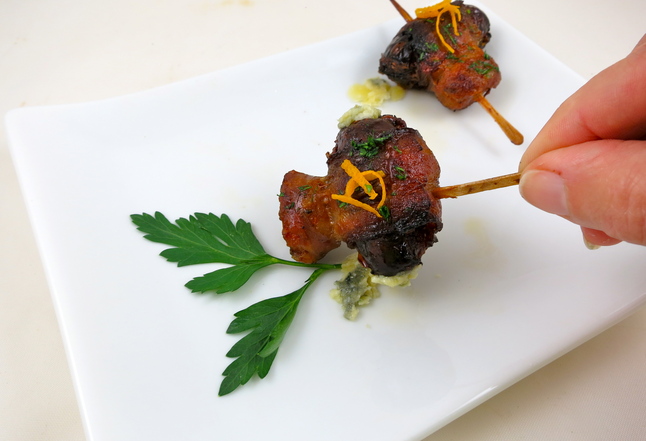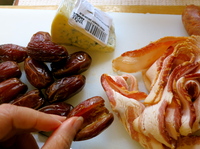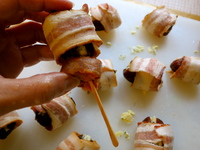Bacon-Wrapped Dates with Blue Cheese & Chorizo - appetizers have synergy of flavors

Bacon-Wrapped Dates with Blue Cheese and Chorizo
Peggy Lampman | Contributor

Sour, salty, bitter, sweet: According to Wikipedia, the average human tongue has 2,000-8,000 taste buds that detect the five elements of taste perception. And, as Richard and I savored a tantalizing stuffed date appetizer at Grange, each of these receptors were hit like a nail on the head. The spicy chorizo, sweet date and salty-sour blue cheese notes were in perfect harmony; each taste complementing the other in a rhapsody of food, resulting in a flavor that was greater than the sum of its parts.

But hold on a minute—what’s that fifth taste perception? Umami (oo-MA-mee), and from what I’ve learned, this is the receptor that may encourage this synergy of flavor. But then again, maybe not; because, according to Wikipedia, umami has no translation.
Ever heard the word? It pops up often in culinary circles, and I wondered if the umami factor also contributes to the palate-pleasing properties of the stuffed dates we enjoyed. I consulted the googlebots to help answer my question.
Umami is a Japanese word meaning “pleasant savory taste,” which is rather broad, especially when the other four tastes conjure a specific sensorial perception. For example: lemons are sour; cocoa is bitter; candy is sweet; and soy sauce is salty. So umami is... what?
Wikipedia describes umami as the ability to balance taste and round the total flavor of a dish, enhancing the palatability of a wide variety of foods. Merriam-Webster describes umami as a taste sensation that is meaty or savory and is produced by several amino acids and nucleotides (as glutamate and aspartate).

From my readings, if you like anchovies, meaty stock, red wine, aged Parmesan, Worcestershire sauce, fish sauce and bonito (fish flakes), you like umami. Fermented soy, asparagus, tomatoes, seaweed and mushrooms are examples of umami-rich vegetables.
The more I read, however, the more confused I become. Some writings give umami a bad rap, equating it with MSG, the evil Darth Vader of the seasoning world. Say what? Tomatoes have MSG? There’s alot of conflicting data; the science behind this fifth sense is complex.
Here’s what David Kasabian, co-author of “The Fifth Taste: Cooking with Umami,” had to say on the subject in a Fox News article, “Oh, Mama. What’s Up With Umami?”
"Unfortunately, many people equate MSG with umami," says Kasabian. "If you use MSG, you taste umami. If you taste umami, then there must be MSG, which ignores the fact that umami exists naturally. Natural glutamates are as fundamentally different from MSG, as perhaps the natural sweetness of a ripe, just-picked strawberry is worlds away from refined sugar. Enhancing taste involves more than adding a chemical. MSG is bereft of the other tastes, aromas, nutrients, sights, smiles, memories and other satisfying sensations that natural umami transports along with it.”
Whew — tomatoes can come out of hiding. But back to the stuffed dates. Do they have umami? According to an article in Readers Digest, “... umami is why we go bonkers for bacon”. I double-dog made sure my recipe hit all five elements of taste perception—including the elusive umami—recreating the Grange appetizer from memory, then wrapping it in bacon. But, really, should recipe development be fraught with such complexity?
Umami, a recent discovery, was made a couple of centuries after the life of Jean Anthelme Brillat-Savarin, arguably the founding father of the gastronomic essay. In M. F.K. Fischer’s translation of his book, The Physiology of Taste: Meditations on Transcendental Gastronomy, Brillat-Savarin wrote,“Good Living is an act of intelligence, by which we choose things which have an agreeable taste rather than those which do not.”
So let’s skip the hogwash behind the why the following recipe is delicious, leaving it at this: These stuffed dates have an agreeable taste. Best said, simply put.
Yield: 12 stuffed dates
Active Time: 20 minutes
Bake Time: apx. 15 minutes
(Note: Dates may be made 3-4 hours in advance. Simply cover with foil and refrigerate; bring to room temperature before cooking.)
Ingredients
12 toothpicks, about 3 1/2-inches long*, soaked 15 minutes
Parchment paper
12 Medjool dates
3-4 ounces cold blue cheese
6 pieces raw bacon (not thick cut), cut in half
1 chorizo sausage link, cut into 12 pieces
1 teaspoon finely chopped parsley
Orange zest
*You need long toothpicks so the chorizo fits. The smaller picks won’t accommodate the chorizo.
Directions
1. Soak toothpicks at least 15 minutes in water to prevent from burning. Preheat oven to 375 degrees and line a baking sheet with parchment paper.
2. Slice dates lengthwise through the center leaving one end intact; remove pit. Stuff date with blue cheese and close. Wrap a piece of bacon around each date. Press a sausage piece against one side of bacon and skewer the date through the sausage and bacon to secure. Repeat with remaining dates.
3. Bake on center rack of oven 7 minutes. Remove from oven and turn dates over. Continue cooking an additional 7 to 9 minutes or until bacon is crispy and sausage is cooked. Serve warm garnished with parsley and orange zest.
Peggy Lampman is a real-time food writer and photographer posting daily feeds on her website and in the Food & Grocery section of Annarbor.com. You may also e-mail her at peggy@dinnerfeed.com.

